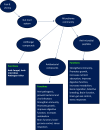Exploration of novel bioactive compounds from the microbiome of fish and shellfish as an alternative to replace antibiotic drugs in aquaculture farming
- PMID: 40548295
- PMCID: PMC12179545
- DOI: 10.1017/gmb.2025.6
Exploration of novel bioactive compounds from the microbiome of fish and shellfish as an alternative to replace antibiotic drugs in aquaculture farming
Abstract
The use of antibiotics in fish and shrimp aquaculture all over the world was found to be only partially successful in preventing infectious diseases. However, their overuse has resulted in the contamination of closed aquatic ecosystems, reduced antibiotic resistance in organisms that fight infectious diseases, and compromised the effectiveness of various antibiotic medications in controlling diseases. Excessive use of antibiotics damages aquaculture species and impacts human health, also rendering the most potent antibiotics increasingly ineffective, with limited alternatives. Therefore, intensive research efforts have been made to replace antibiotics with other protocols and methods like vaccines, phage therapy, quorum quenching technology, probiotics, prebiotics, chicken egg yolk antibody (IgY), and plant therapy," etc. Though all these methods have great potential, many of them are still in the experimental stage, except for fish vaccines. All these alternative technologies need to be carefully standardized and evaluated before implementation. In recent times, after realizing the importance of the gut microbiome community in maintaining the health of animals, efforts have been made to use the microbiome strains for the prevention of pathogenic bacterial and viral infections. Now it has been experimentally proven that animals should possess a healthy microbiome community in their gut tract to strengthen the immune system and prevent the entry of harmful pathogens. Investigations are now being carried out on the derivation of various bioactive compounds from the gut microbiome strains and their structural profile and functionality using the molecular tools of metagenomics and bioinformatics. Such newly discovered compounds from microbiomes can be used as potential alternatives to replace antibiotic drugs in the aquaculture industry. These alternatives are likely to emerge as breakthroughs in animal health management and farming, with effects on cost efficiency, species health, productivity, and yield enhancement. Therefore, introducing new micro-innovative technologies into an overall health management plan will be highly beneficial.
Keywords: antibiotics; aquaculture; bioactive compounds; gut microbiome; therapies.
© The Author(s) 2025.
Figures
Similar articles
-
Synbiotics, prebiotics and probiotics for solid organ transplant recipients.Cochrane Database Syst Rev. 2022 Sep 20;9(9):CD014804. doi: 10.1002/14651858.CD014804.pub2. Cochrane Database Syst Rev. 2022. PMID: 36126902 Free PMC article.
-
Home treatment for mental health problems: a systematic review.Health Technol Assess. 2001;5(15):1-139. doi: 10.3310/hta5150. Health Technol Assess. 2001. PMID: 11532236
-
A rapid and systematic review of the clinical effectiveness and cost-effectiveness of paclitaxel, docetaxel, gemcitabine and vinorelbine in non-small-cell lung cancer.Health Technol Assess. 2001;5(32):1-195. doi: 10.3310/hta5320. Health Technol Assess. 2001. PMID: 12065068
-
Cost-effectiveness of using prognostic information to select women with breast cancer for adjuvant systemic therapy.Health Technol Assess. 2006 Sep;10(34):iii-iv, ix-xi, 1-204. doi: 10.3310/hta10340. Health Technol Assess. 2006. PMID: 16959170
-
Systemic pharmacological treatments for chronic plaque psoriasis: a network meta-analysis.Cochrane Database Syst Rev. 2021 Apr 19;4(4):CD011535. doi: 10.1002/14651858.CD011535.pub4. Cochrane Database Syst Rev. 2021. Update in: Cochrane Database Syst Rev. 2022 May 23;5:CD011535. doi: 10.1002/14651858.CD011535.pub5. PMID: 33871055 Free PMC article. Updated.
References
-
- Abe M and Nakazawa T (1994) Characterization of hemolytic and antifungal substance, cepalycin, from Pseudomonas cepacia. Microbiology and Immunology 38, 1–9. - PubMed
Publication types
LinkOut - more resources
Full Text Sources

